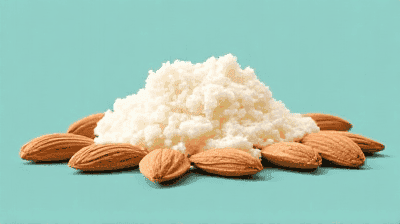
Water is an essential resource for agriculture and food production, but its availability is becoming increasingly strained due to climate change, population growth, and over-extraction. As consumers become aware of the environmental impacts of their food choices, questions regarding water usage in food production have emerged, especially concerning popular products like almond milk. Almond milk has often been criticized for its high water usage in production. However, the reality is more nuanced.
A water footprint is a measure of the total volume of freshwater used to produce a good or service. This includes both direct water use (for irrigation, processing, and transportation) and indirect water use (the water used to grow feed crops, for example). The water footprint is often broken down into three components:
Green Water: Refers to the rainfall that is stored in the soil and used by plants. This is essentially the natural water cycle's contribution to agriculture.
Blue Water: Refers to freshwater extracted from rivers, lakes, and aquifers for irrigation and other domestic purposes.
Grey Water: Represents the amount of freshwater needed to dilute pollutants to a safe level and is often a measure of water pollution.
Understanding these categories helps us assess the total impact of food products on freshwater resources.
Water is a finite resource, especially in arid regions where agriculture often relies heavily on irrigation. As climate change leads to changes in precipitation patterns and increased evaporation rates, the demand for sustainable water management becomes essential. With food production accounting for approximately 70% of global freshwater usage, understanding the water costs associated with our food choices is critical for making informed, sustainable dietary decisions.

Certain food items are known for their significant water requirements during production. Here’s a look at some of the highest water-consuming foods:
Beef: Producing one kilogram of beef can require upwards of 15,000 liters of water when considering feed crops, processing, and animal hydration.
Dairy: Dairy products also have substantial water footprints. For instance, producing one liter of milk typically uses around 1,000 liters of water.
Nuts: Almonds, in particular, garner attention for their high water usage, with estimates suggesting that producing one kilogram of almonds requires approximately 12,000 liters of water.
Rice: A staple food for many, rice cultivation requires large amounts of water due to its flooded field growing technique, with estimates ranging between 2,500 and 5,000 liters of water per kilogram.
When evaluating the water costs of different food products, context matters significantly. Examining the water footprints of almond milk relative to dairy milk and other plant-based alternatives provides a clearer picture:
Almond Milk: Producing one liter of almond milk requires approximately 560 liters of water, primarily due to the water-intensive nature of almond cultivation.
Dairy Milk: The production of one liter of dairy milk typically requires around 1,000 liters of water. This figure accounts for the water used for feed crops and the hydration of dairy cows.
Soy Milk: Producing one liter of soy milk requires about 297 liters of water, making it a more water-efficient choice compared to both almond and dairy milk.
Oat Milk: Oat milk is even more efficient, with about 48 liters of water required for each liter produced, primarily relying on rainfall.
Rice Milk: Rice milk production involves significant water use corresponding to its cultivation, averaging around 315 liters per liter of milk.
Almond milk is popular among consumers seeking dairy alternatives for various reasons, including lactose intolerance, veganism, and health consciousness. Its nutritional profile includes:
Low in Calories: Unsweetened almond milk typically contains about 30 to 50 calories per cup, which is significantly lower than whole dairy milk.
Rich in Vitamin E: Almond milk is a good source of vitamin E, an antioxidant that helps protect cells from oxidative damage.
Low Sugar: Unsweetened almond milk is low in sugar, making it an appealing option for those monitoring their sugar intake.
While water use is an important consideration, other environmental factors must also be acknowledged. Here’s how almond milk stacks up:
Land Use: Almond cultivation requires less land than dairy farming. One study estimates producing one liter of almond milk may require around 0.13 square meters of land compared to approximately 0.44 square meters for dairy milk.
Greenhouse Gas Emissions: Almond milk generally has a lower carbon footprint than dairy. Livestock farming contributes significantly to methane emissions. In contrast, almond production does not rely heavily on livestock, resulting in lower greenhouse gas emissions overall.
Pesticides and Fertilizers: Almond production can involve certain pesticide use, but organic almond milk options are widely available. Dairy farming often necessitates higher chemical inputs due to the need for feed crop production.

To determine the viability of almond milk within our diets, let’s examine how it measures up against other milk alternatives and its environmental impacts.
| Beverage Type | Water Use (liters per liter) | Calories per cup | Nutritional Highlights | Environmental Considerations |
|---|---|---|---|---|
| Almond Milk | 560 | 30-50 | Vitamin E | High water use, lower GHG emissions |
| Dairy Milk | 1,000 | 150 | Protein, Calcium | High water use, high GHG emissions |
| Soy Milk | 297 | 80 | Protein, Isoflavones | Moderate water use, lower GHG emissions |
| Oat Milk | 48 | 70-120 | Fiber, B Vitamins | Low water use, very low GHG emissions |
| Rice Milk | 315 | 120 | Low protein | Moderate water use, GHG emissions depend on rice method |
From this comparison, it’s clear that while almond milk does require more water than soy or oat milk, it remains less than dairy milk. Importantly, it also provides health benefits that align with many consumers’ dietary preferences.
Oat milk stands out as the most water-efficient option, yet almond milk still presents a compelling case for those seeking healthful, lower-calorie beverages. The choice among these alternatives ultimately depends on personal preferences and dietary requirements.
Adopting a diverse diet that includes a variety of plant-based foods can mitigate environmental concerns associated with specific products. Rather than fixating solely on the water costs of almond milk, consumers should strive for a balanced dietary approach that includes fruits, vegetables, whole grains, legumes, nuts, and various plant-based proteins.
Incorporating a range of foods allows communities to embrace local and seasonal produce, emphasize nutrition, and reduce reliance on any single food commodity.
Supporting sustainable farming practices can be beneficial in mitigating the water costs associated with food production. Practices such as:
Drip Irrigation: More efficient irrigation systems can significantly reduce water usage in almond cultivation and other agricultural practices.
Rainwater Harvesting: Systems that capture rainwater can be implemented on farms to supplement irrigation needs and reduce dependence on groundwater and surface water sources.
Crop Rotation and Cover Cropping: Implementing these practices helps enhance soil health and reduce water runoff, thereby contributing to increased water retention in the soil.
By advocating for sustainable practices and supporting products that prioritize water efficiency and responsible farming, consumers can contribute to a more resilient food system.

Consumers can make informed choices that help address the hidden water costs of food production:
Choose Local and Seasonal: Sourcing food locally reduces transportation impacts and often relies on varieties of food that are well-suited to the climate, thus conserving water.
Incorporate Diverse Plant-Based Foods: Emphasizing a variety of plant-based foods can help lighten the water demand on agriculture systems.
Be Mindful of Overhead Water Costs: Stay informed about the water usage of one’s favored products and across various producing regions, allowing for more sustainable purchases.
Support Sustainable Brands: Invest in brands that prioritize sustainable farming practices and transparency regarding water resource management.
Engaging in conversations around food choices, sustainability, and water usage is vital. Community-level discussions can lead to grassroots initiatives and awareness campaigns emphasizing reducing water costs in agriculture.
Education and outreach play a key role in empowering consumers and fostering a greater understanding of water use within food systems.
While the water costs associated with food production, particularly for almond milk, often draw scrutiny, the broader context of food choices reveals a more intricate picture. Almond milk, while water-intensive, is a viable alternative to dairy milk, providing numerous nutritional benefits and a lower overall environmental impact in terms of greenhouse gas emissions.
Ultimately, promoting a flexitarian approach that emphasizes diverse, plant-based foods empowers consumers to reduce their water footprint and cultivate a more sustainable food system. By understanding the hidden water costs, consumers can make informed choices that benefit their health and the environment. The key lies in embracing flexibility and diversity in dietary choices while advocating for sustainable agriculture practices that prioritize water efficiency and resource stewardship.